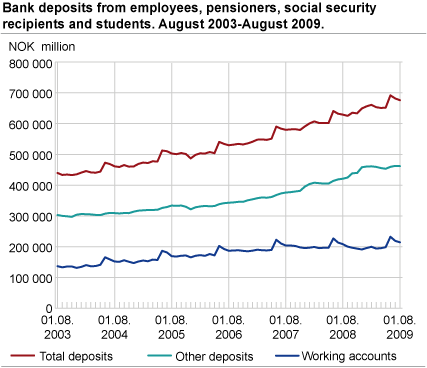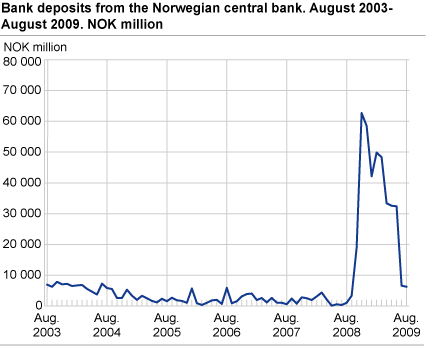Content
Published:
This is an archived release.
Increase in households' bank deposits
Norwegian households' deposits in Norwegian banks were NOK 783 billion at end-August 2009. The deposits have increased by NOK 48 billion, or 6.6 per cent compared to August last year. With the exception of the two previous months, this is the highest level ever recorded.
Total deposits in Norwegian banks amounted to NOK 2 292 billion at the end of August 2009. This is a decrease of NOK 31 billion, or 1.3 per cent, from July, but an increase of NOK 164 billion, or almost 8 per cent compared to the equivalent period last year.
Bank deposits from employees at an unprecedented level
The household sector consists of quasi-corporate private enterprises (e.g. partnerships), private non-profit institutions serving households, unincorporated private enterprises, employees, pensioners, social security recipients and students. A total of 86 per cent of the households’ bank deposits, or NOK 676 billion, is from the sub group employees, pensioners, social security recipients and students.
Bank deposits from employees etc. have increased by NOK 47 billion, or 7.5 per cent, from August last year. Compared to June and July this year, however, bank deposits have decreased by NOK 16 and 6 billion respectively, but this is not surprising. There is a prevalent seasonal pattern in bank deposits from employees etc.; every year in June these deposits increase rapidly. The most important reason for this is holiday pay and tax refunds which employees receive in the middle of June each year. With the exception of June and July this year, total bank deposits from employees, pensioners, social security recipients and students were at an all-time high at end-August 2009.
Of the total bank deposits from employees etc. of NOK 676 billion, NOK 214 billion were deposits in working accounts, while other deposits amounted to NOK 462 billion. Deposits in working accounts have increased by almost NOK 6 billion, or 3 per cent, compared to August last year, while other deposits have increased by NOK 41 billion, or 9.7 per cent in the same period.
Decrease in bank deposits from non-financial corporations following an all-time high in July
Bank deposits from non-financial corporations increased quite rapidly from May 2005 to December 2007, followed by a decrease that lasted until May 2008. In December 2008 the deposits again reached an unprecedented level which lasted until February 2009, by then deposits were decreasing again. Following yet another all-time high of NOK 511 billion in July, deposits decreased in August. At end-August 2009 bank deposits from non-financial corporations amounted to NOK 504 billion. This is an increase of NOK 11 billion, or 2.3 per cent compared to the equivalent period last year.
Decrease in deposits from abroad, increased deposits from other Norwegian banks and mortgage companies
Bank deposits from financial corporations have also had a sharp increase the last couple of years. Since 2003, these deposits have increased by a total of NOK 572 billion, or 252 per cent. In the last year the growth has been close to 16 per cent; equivalent to NOK 110 billion. From March 2009, however, deposits from financial corporations have decreased every month. At end-August 2009 these deposits were almost NOK 800 billion.
Foreign financial corporations accounted for a total of 86 per cent of financial corporations’ deposits in Norwegian banks at end-August 2009, which amounts to NOK 684 billion. Deposits fell by NOK 9 billion, or 1.3 per cent compared to July this year. Compared to August last year, however, deposits from financial corporations increased by close to 75 billion, or 12.3 per cent.
Deposits from other Norwegian banks, which accounted for approximately 10 per cent of the financial corporations’ total deposits in Norwegian banks at end-August 2009, were close to NOK 79 billion. The increase in these deposits was NOK 3.7 billion, or 5 per cent compared to July this year. Compared to the equivalent period last year, deposits from other Norwegian banks increased by a total of NOK 21 billion, or 36.6 per cent.
Norwegian mortgage companies accounted for a modest 3 per cent of the financial corporations’ total bank deposits at end-August 2009, with NOK 26 billion. The increase in these deposits was NOK 3.7 billion, or a total of 16.6 per cent from July this year. Compared to August 2008, deposits from Norwegian mortgage companies increased by NOK 7 billion, or 35.5 per cent.
Deposits from the central bank returns to a more normal level
Deposits from the Norwegian central bank have been lower than NOK 10 billion for several years, but from October 2008 to June 2009, in the wake of the financial turmoil, there was a sharp increase in these deposits. In this period, deposits from the Norwegian central bank were between NOK 19 and 63 billion and accounted for nearly 7 per cent of total deposits from financial corporations. In July and August 2009, however, these deposits returned to a more normal level. At end-August 2009, deposits from the Norwegian central bank were NOK 6 billion, and accounted for a very modest 0.78 per cent of total deposits from financial corporations.
Deposits in working accounts versus other depositsDeposits in working accounts are deposits that can be used for direct transactions without generating any additional costs to ordinary transaction costs. Other deposits include deposits on accounts that cannot be used for direct transactions without generating any additional costs to ordinary transaction costs, or accounts with restrictions on direct transactions. Traditionally, wage accounts have been classified as working accounts, while savings accounts have been classified in the category 'other deposits'. Wage accounts are still clearly classified as working accounts, but the difference between wage accounts and savings accounts has been more and more blurred over the years. Many banks no longer have restrictions on direct transactions on either of these accounts. Consequently, both working accounts and other deposits must be considered when analysing households' saving patterns, however, it is still assumed that most high-interest savings accounts are put in the category other deposits. |
The statistics is now published as Banks and mortgage companies.
Contact
-
Statistics Norway's Information Centre
E-mail: informasjon@ssb.no
tel.: (+47) 21 09 46 42


